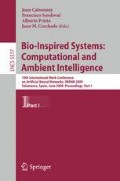Abstract
The objective of the work described in this paper is twofold. On the one hand, the aim is to present and validate a model of Dengue fever for the Cuban case which is defined by a delay differential system. Such a model includes time-varying parameters, which are estimated by means of a method based upon Hopfield Neural Networks. This method has been successfully applied in both robotic and epidemiological models described by Ordinary Differential Equations. Therefore, on the other hand, an additional aim of this work is to assess the behaviour of this neural estimation technique with a delay differential system. Experimental results show the ability of the estimator to deal with systems with delays, as well as plausible parameter estimations, which lead to predictions that are coherent with actual data.
This work has been partially supported by the Agencia Española de Cooperación Internacional para el Desarrollo (AECID), project no. D/017218/08. Thanks are due to Dr. Hector de Arazoza for his useful suggestions and, in particular, for providing the model of Dengue epidemics.
Access this chapter
Tax calculation will be finalised at checkout
Purchases are for personal use only
Preview
Unable to display preview. Download preview PDF.
References
Ljung, L.: System Identification. Theory for the User. Prentice-Hall, Englewood Cliffs (1999)
Unbehauen, H.: Some New Trends in Identification and Modeling of Nonlinear Dynamical Systems. Applied Mathematics and Computation 78, 279–297 (1996)
Atencia, M.A., Joya, G., Sandoval, F.: Parametric Identification of Robotic Systems with Stable Time-varying Hopfield Networks. Neural Computing & Applications 13(4), 270–280 (2004)
Atencia, M.A., Joya, G., Sandoval, F.: Modelling the HIV-AIDS Cuban Epidemics with Hopfield Neural Networks. In: Mira, J., Álvarez, J.R. (eds.) IWANN 2003. LNCS, vol. 2687, pp. 449–456. Springer, Heidelberg (2003)
Atencia, M.A., Joya, G., García-Garaluz, E., Arazoza, H., Sandoval, F.: Estimation of the Rate of Detecction of Infected Individuals in an Epidemiological Model. In: Sandoval, F., Prieto, A.G., Cabestany, J., Graña, M. (eds.) IWANN 2007. LNCS, vol. 4507, pp. 948–955. Springer, Heidelberg (2007)
Bailey, N.T.: The mathematical theory of infectious diseases and its applications. Ch. Griffin and Company LTD (1975)
Esteva, L., Vargas, C.: A model for dengue disease with variable human population. Journal of Mathematical Biology 38(3), 220–240 (1999)
Coutinho, F., Burattini, M., Lopez, L., Massad, E.: Threshold conditions for a non-autonomous epidemic system describing the population dynamics of dengue. Bulletin of Mathematical Biology 68(6), 2263–2282 (2006)
Hopfield, J.: Neural Networks and physical systems with emergent collective computational abilities. Proc. Natl. Acad. Sci. USA 79, 2554–2558 (1982)
Tank, D., Hopfield, J.: ’Neural’ Computation of Decisions in Optimization Problems. Biological Cybernetics 52, 141–152 (1985)
Abe, S.: Theories on the Hopfield Neural Networks. In: Proc. IEE International Joint Conference on Neural Networks, vol. I, pp. 557–564 (1989)
Atencia, M.A., Joya, G., Sandoval, F.: Dynamical Analysis of Continuous Higher Order Hopfield Networks for Combinatorial Optimization. Neural Computation 17(8), 1802–1819 (2005)
Author information
Authors and Affiliations
Editor information
Editors and Affiliations
Rights and permissions
Copyright information
© 2009 Springer-Verlag Berlin Heidelberg
About this paper
Cite this paper
García-Garaluz, E., Atencia, M., García-Lagos, F., Joya, G., Sandoval, F. (2009). System Identification of Dengue Fever Epidemics in Cuba. In: Cabestany, J., Sandoval, F., Prieto, A., Corchado, J.M. (eds) Bio-Inspired Systems: Computational and Ambient Intelligence. IWANN 2009. Lecture Notes in Computer Science, vol 5517. Springer, Berlin, Heidelberg. https://doi.org/10.1007/978-3-642-02478-8_113
Download citation
DOI: https://doi.org/10.1007/978-3-642-02478-8_113
Publisher Name: Springer, Berlin, Heidelberg
Print ISBN: 978-3-642-02477-1
Online ISBN: 978-3-642-02478-8
eBook Packages: Computer ScienceComputer Science (R0)

